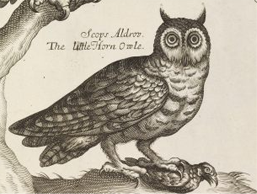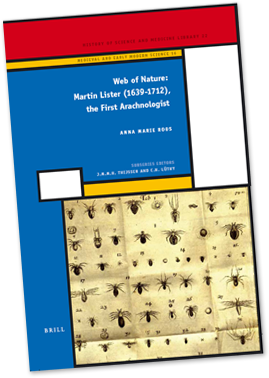* You are viewing Posts Tagged ‘Arachnology’
James Brown
January 11, 2012
Conferences and Workshops, Events, Project Updates
Tags: Animals, Arachnology, Conchology, History of Science, Martin Lister, Natural History, Royal Society, Seventeenth Century
Update: see write-up, photos, and podcasts

A seventeenth-century rendering of a little horn (or screech) owl.
A day conference on History Comes to Life: Seventeenth-Century Natural History, Medicine and the New Science‚ will be held on Friday 27 April 2012 from 9am to 5.30pm at The Royal Society in London. Organised by our industrious Martin Lister (1639-1712) Research Fellow Anna Marie Roos, and held to commemorate the 300th anniversary of Lister – Royal Physician and the first arachnologist and conchologist – the event will explore the often neglected relationship between medicine and natural history in the seventeenth-century. Featuring an exciting line-up of ten international authorities on early modern science, the meeting will dovetail out from Lister’s work to consider to what extent practices and technologies of natural history changed between the Renaissance and the seventeenth century. It will also explore how the acquisition of natural history knowledge and new schemes of taxonomy influenced the perception and treatment of animals for medical and experimental use. As well as support from Cultures of Knowledge, the conference is sponsored by The John Fell Fund, The British Society for the History of Science, The Royal Society, and the Wellcome Trust. The conference fee is a bargain at £40 (full price) or £30 (student/unwaged). For further details and to register online, please visit the conference webpage. Please address queries to felicity.henderson(at)royalsociety.org.

The cause for celebrations.

AMR and the befitting baked goods.

A closer look at the felicitous fancies.

The launch in full swing.
The biography of Martin Lister recently published by our Research Fellow Anna Marie Roos was officially launched this Tuesday at a small but perfectly formed reception in the splendid environs of the Royal Society Library in London. Around thirty guests gathered to mark the appearance of Web of Nature: Martin Lister (1639-1712), the First Arachnologist (Brill, 2011) and, during the course of the evening, they were treated to selected readings from Anna Marie, wines from French vineyards visited by Lister (sourced by Anna Marie while researching Lister’s medical journal), and some thematically congruous cupcakes bearing illustrations from Lister’s arachnological and conchological masterworks. Many thanks to Anna Marie for suggesting the idea, to Brill for their generous financial support, and to all at the Royal Society (with special shout-outs to Felicity Henderson and Keith Moore) for allowing us the use of their wondeful venue, for hosting us so graciously, and for all of their assistance with preparations. For more information about the book and to purchase copies, please visit Brill’s website or download the flyer (pdf).
 Update: see photos of the launch
Update: see photos of the launch
We are delighted to announce the publication of a monograph by our Martin Lister Research Fellow Dr Anna Marie Roos. Web of Nature: Martin Lister (1639-1712), the First Arachnologist (Brill, 2011) is the first and only full-length biography of the prominent naturalist and physician. Drawing on rich archival sources (including over 1,100 surviving letters, which Roos is also editing under the auspices of the Project), Roos provides a detailed picture of what it meant to be a virtuoso in the seventeenth-century Republic of Letters. Lister, described by Robert Boyle as a researcher of ‘piercing sagacity’, discovered ballooning spiders, while his work on molluscs was standard for 200 years. However, he also invented the histogram, provided Sir Isaac Newton with chemical procedures and alloys for his telescopic mirrors, demonstrated that York’s walls were Roman, received the first reports of Chinese smallpox vaccination, donated the first significant natural history collections to the Ashmolean Museum, and was involved in the day-to-day administration of the Royal Society in its formative years. His study of natural history represents a conceptual bridge between the work of Renaissance naturalists and those of the Enlightenment, while the impact of his research extended into Jamaica, America, Barbados, France, Italy, the Netherlands, China, as well as his native England. Roos also disentangles the significant webs of knowledge, patronage, familial, and gender relationships that shaped Lister’s life as a natural philosopher, presenting a humanistic and holistic view of early science. For more information about the book, please visit the publisher website or download the flyer (pdf).








 Join
Join 